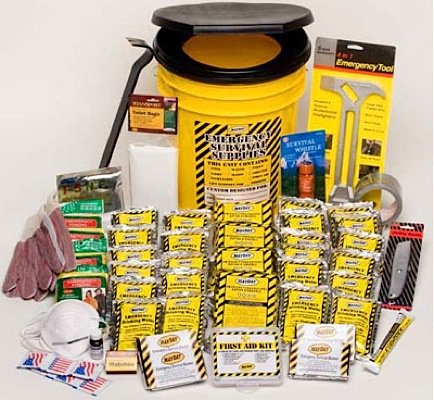We were fortunate in some respects, I had made a little book to explain earthquakes to our children and their friends. That was the way we used to teach them such things as pulling the blanket up over their heads, and it helped them stay calm. Many of the things I'm writing in this article can be applied to many natural disasters.
Children are curious, and it's hard to say how much they can absorb how soon. They need to know earthquakes are a part of nature, and if they live in a seismically active area they need to know that. Sit down with them and discuss your family's disaster plan.
When you make the earthquake kit, have them help. They will probably have some good ideas. You can discuss the reasons for many of the items at the same time.
Building Your Kit:
For the kids: Age appropriate foods should be included. Baby food, formula and the like will have to be rotated out regularly, but it should be in there. Other baby and toddler needs include diapers, wipes, rash cream, teething gel, teething rings, bottles, "sippy cups," pacifiers and so on should be included.
Toys: It might be wise not to show the children what toys you are putting into the kit, for two reasons. They may want to get them out before they are needed, and having a nice surprise could be a good emotional boost for them. Coloring books, drawing paper, crayons or markers are a good start. Older kids might enjoy board games, books and other age appropriate entertainments. If they have a hand held game (and it manages to survive the earthquake), extra batteries are a good idea.
Other Items: Food for a minimum of three days, but preferably for two weeks. Though it takes up more space, canned goods are better than dry goods, due to the possible shortage of water. Canned meats, vegetables and fruits are all good. You may want to add treat foods, both for you and the kids. Pots, pans, etc. should be available as well as a means to cook your food.
Water is an important addition. You'll need one gallon of water per person per day minimum. Utilities could be out for as much as two weeks, so keep that in mind when calculating both food and water.
Don't forget the pets. Canned and dry pet food should be kept in your kit. If the pet is a cat, a bag of litter could be useful as well. Again, toys and treats for the pet are not a bad idea, they will be as stressed as you are, and perhaps more as they don't understand what's happening.
Sanitation needs: Even if you use disposable eating products, you will still need to wash a few things. Dishsoap is a good addition. So is soap to keep yourselves clean, though you may be able to find alternatives at a backpacking store. In fact, you may find a lot of useful stuff there for your kit.
You'll need garbage bags for two reasons, and trash is only one. You can convert the bags into a means of getting rid of human waste as well. Again, the backpacking store may have better alternatives. Paper products, such as toilet paper, Kleenex and feminine supplies should be added. Paper towels are another good addition.
You'll need a variety of batteries. Flashlights and the radio are musts, though you may have a battery operated TV, game consoles, lanterns and other battery operated products.
Clothing should be added to your kit. If the earthquake happens at night, you're not going to want to spend the next few days in your pajamas. You'll want to rotate the clothes, warmer for winter and cooler for summer. You may also want to have blankets, sleeping bags and/or a tent.
First aid and medications: Earthquakes are violent affairs, and there may be some injuries. If the quake is big enough, you may have to do some first aid while waiting for professional help. A standard kit contains pain relievers, antihistamines, bandages and the like. These are important, but you may need more. Some means to stabilize a broken bone, hold a gash together and so on are also considerations. We have a professionally put together emergency kit, plus my addition of herbal remedies that may be useful.
Prescription medications, eye glasses and other health aids may need to be stowed in the in your kit. If you live with an older person, they could need a walker to get around. If you have room, these are very useful. Extra batteries for hearing aids should be available if they are needed.
As you read this, you may come up with other additions to your kit. Bear in mind what I said in a previous article, be careful where you store your kit. If it's not secured outside, someone very easily could swipe it. If it's in your house, you may not be able to get to it. In either case, it will do you no good.
If you are fortunate enough to have an RV or travel trailer, you can use it to store your kit. This will allow you to add more things that can help maintain some level of comfort in a really uncomfortable time.











